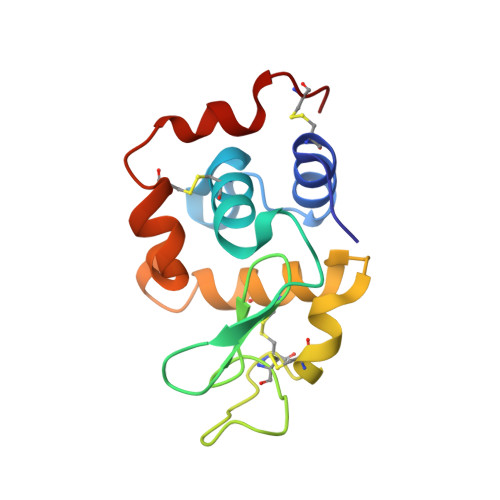Fine-tuning non-covalent interactions between hybrid metal-oxo clusters and proteins.
Lentink, S., Salazar Marcano, D.E., Moussawi, M.A., Vandebroek, L., Van Meervelt, L., Parac-Vogt, T.N.(2023) Faraday Discuss 244: 21-38
- PubMed: 37102318
- DOI: https://doi.org/10.1039/d2fd00161f
- Primary Citation of Related Structures:
8BQP, 8BQQ, 8BQR, 8BQT - PubMed Abstract:
Interactions between the protein Hen Egg White Lysozyme (HEWL) and three different hybrid Anderson-Evans polyoxometalate clusters - AE-NH2 (δ-[MnMo 6 O 18 {(OCH 2 ) 3 CNH 2 } 2 ] 3- ), AE-CH3 (δ-[MnMo 6 O 18 {(OCH 2 ) 3 CCH 3 } 2 ] 3- ) and AE-Biot (δ-[MnMo 6 O 18 {(OCH 2 ) 3 CNHCOC 9 H 15 N 2 OS} 2 ] 3- ) - were studied via tryptophan fluorescence spectroscopy and single crystal X-ray diffraction. Quenching of tryptophan fluorescence was observed in the presence of all three hybrid polyoxometalate clusters (HPOMs), but the extent of quenching and the binding affinity were greatly dependent on the nature of the organic groups attached to the cluster. Control experiments further revealed the synergistic effect of the anionic polyoxometalate core and organic ligands towards enhanced protein interactions. Furthermore, the protein was co-crystallised with each of the three HPOMs, resulting in four different crystal structures, thus allowing for the binding modes of HPOM-protein interactions to be investigated with near-atomic precision. All crystal structures displayed a unique mode of binding of the HPOMs to the protein, with both functionalisation and the pH of the crystallisation conditions influencing the interactions. From the crystal structures, it was determined that HPOM-protein non-covalent complexes formed through a combination of electrostatic attraction between the polyoxometalate cluster and positively charged surface regions of HEWL, and direct and water-mediated hydrogen bonds with both the metal-oxo inorganic core and the functional groups of the ligand, where possible. Hence, functionalisation of metal-oxo clusters shows great potential in tuning their interactions with proteins, which is of interest for several biomedical applications.
- Department of Chemistry, KU Leuven, Celestijnenlaan 200F, Leuven 3001, Belgium. tatjana.vogt@kuleuven.be.
Organizational Affiliation:



















